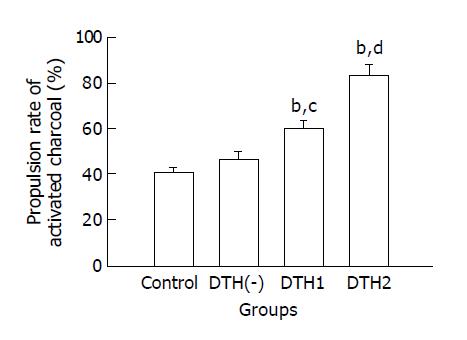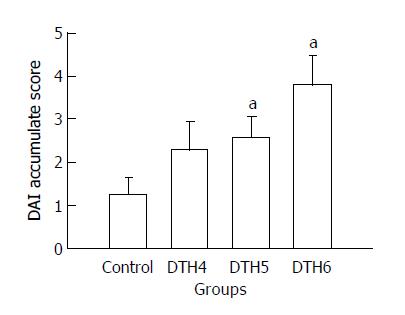Copyright
©The Author(s) 2004.
World J Gastroenterol. Aug 1, 2004; 10(15): 2254-2258
Published online Aug 1, 2004. doi: 10.3748/wjg.v10.i15.2254
Published online Aug 1, 2004. doi: 10.3748/wjg.v10.i15.2254
Figure 1 Effect of DNCB gavage on gastrointestinal motility in sensitized mice.
bP < 0.01 vs control, cP < 0.05 vs DTH(-), dP < 0.01 vs DTH(-) and DTH1n = 8 in control; n = 7 in DTH(-), DTH1 and DTH2 groups.
Figure 2 Effect of DNCB enema on DAI score in sensitized mice.
aP < 0.05 vs control. n = 16 in control group and DTH4 group; n = 11 in DTH5 group; n = 17 in DTH6 group.
Figure 3 The pathological change of colon by DNCB enema in sensitized mice.
A1: control 600 mL/L ethanol, normal histological structures. A2: DTH(-), only slight mucosa congestion. B: 1 g/L DNCB, hyperemia, infiltration of chronic inflammatory. cells, decrease of the number of goblet cell in colon mucosa. C: 2 g/L DNCB, superficial erosion, chronic inflammation of colon mucosa. D: 4 g/L DNCB, atrophic changes of colon mucosa with chronic inflammation. E: 4 g/L DNCB, ulcer and hemorrhage in colon mucosa (HE, ×200).
Figure 4 Pathological score in the mice received DNCB enema after sensitization.
4A: macropathology; 4B: microscopically observation. group 1: control (600 mL/L ethanol, n = 16); group 2: DTH4 (1 g/L DNCB, n = 17); group 3: DTH 5 (2 g/L DNCB, n = 17); and group 4: DTH6 (4 g/L DNCB, n = 17) aP < 0.05 vs group 4A1 and 4B1, respectively.
- Citation: Yu WG, Lin P, Pan H, Xiao L, Gong EC, Mei L. Pathophysiological significance of a reaction in mouse gastrointestinal tract associated with delayed-type hypersensitivity. World J Gastroenterol 2004; 10(15): 2254-2258
- URL: https://www.wjgnet.com/1007-9327/full/v10/i15/2254.htm
- DOI: https://dx.doi.org/10.3748/wjg.v10.i15.2254












